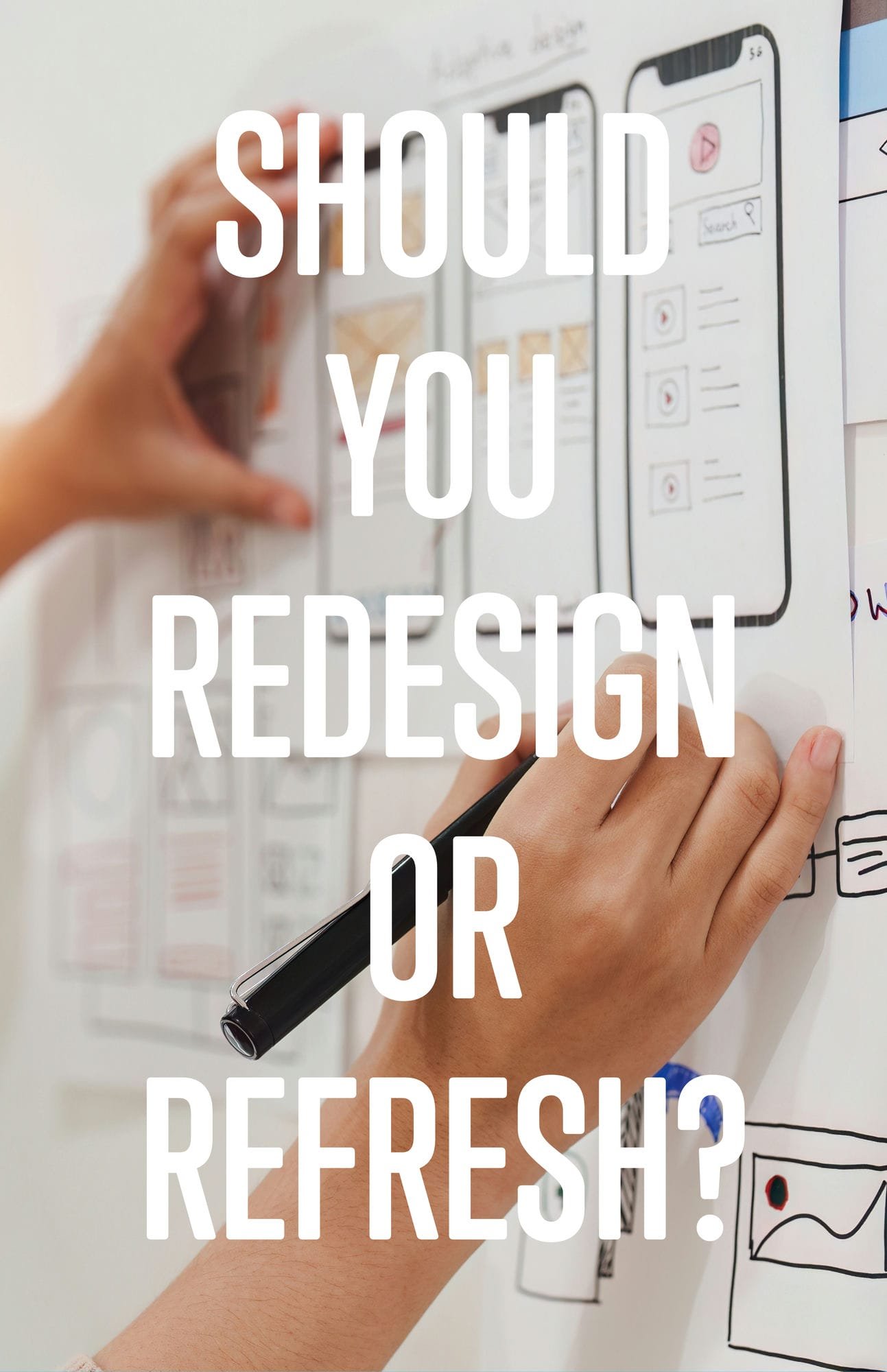
Ever stared at your website and felt something was just not quite right, yet couldn’t pinpoint the issue? You’re in good company. In a world where change is the only constant, figuring out what kind of update your website needs can be a head-scratcher. Your options usually fall into one of two camps: a total website makeover or a lighter, tactical refresh. Choose poorly, and you might find yourself investing valuable time and money into efforts that don’t resonate with your objectives or audience.
Deciding between a full-on redesign and a simpler refresh isn’t just about looks; it’s a question of functionality, user satisfaction, and yes, even impacting your revenue. In this blog post, we’ll dig deep into the distinctions between these two types of changes and offer cues to help you identify which is the right fit for you. Whether you’re a budding entrepreneur, a savvy marketing guru, or someone tasked with overseeing a website, this post aims to arm you with the knowledge you need to make a well-informed decision.
The Difference Between a Redesign and a Refresh
Understanding the core differences between a website redesign and a website refresh is crucial for making the right decision. Both options have their merits, but they cater to different needs and scenarios.
Here’s how they stack up:
Redesign
When you opt for a redesign, you’re essentially hitting the reset button. This is a ground-up rework that touches everything—from the site’s visual appeal to its underlying mechanics. It’s the equivalent of demolishing a house to build a mansion in its place.
- Visual Overhaul: Think new color schemes, layouts, and possibly even logos. The goal is a transformative visual experience for your users.
- User Interface Changes: A redesign often brings with it an updated navigation system, fresh menu layouts, and potentially a completely new way for users to interact with the site.
- Content Shift: Sometimes, a redesign may also necessitate a change in content, including text, images, and multimedia elements, to align with the new look and feel.
- Tech Stack and Architecture: If your site’s on outdated tech, a redesign can provide the opportunity to move to a newer, more efficient platform. This is your chance to clean up messy code and optimize for performance.
Refresh
A refresh, on the other hand, is more like redecorating your room rather than moving to a new house. It’s all about making targeted updates that improve your website without fundamentally changing its structure or core identity.
- Usability Tweaks: These are often minor changes aimed at enhancing the user experience—think better button placement or simplified forms.
- Visual Updates: A refresh might involve changing the color of call-to-action buttons, updating fonts, or swapping out images to inject new life into the design.
- Performance: If your site is generally in good shape but could use a speed boost or better mobile responsiveness, a refresh can focus solely on these aspects.
Indicators That You May Need a Redesign
Deciding to completely revamp your website is a big commitment, both in terms of time and resources. To make this decision easier, here are some telling signs that indicate it might be time for a full redesign:
Outdated Technology
Older technology can become a bottleneck for your website, affecting not just its performance but also the user experience. Imagine trying to run the latest apps on a decade-old phone. It’s frustrating and slow, right? The same holds true for your website. Outdated technology could mean slower loading times, compatibility issues, and frequent downtimes—all of which contribute to a poor user experience.
Poor User Experience
Speaking of user experience, high bounce rates and low user engagement are red flags. If people are coming to your website but not sticking around, or if they’re leaving without taking any actions (like making a purchase or filling out a contact form), it’s a sign that your website isn’t meeting their needs or expectations. A redesign can help you implement more effective navigational structures, more engaging content, and better calls-to-action.
Rebranding
If your business has recently undergone a rebranding, it’s essential that your website reflects these changes. Consistency is key in branding, and an outdated website can send mixed signals to your audience. A redesign can align your website with your new brand guidelines, creating a seamless experience across all touchpoints.
SEO Underperformance
It’s hard to overstate the importance of SEO in today’s competitive marketplace. Older website designs often lack the structural elements that make them easy to crawl and index, which can lead to poor search engine rankings. If your site is not performing well in search results, it may be time to consider a redesign focused on SEO optimization.
Signs You Might Just Need a Refresh
Not every issue with your website calls for a complete makeover. Sometimes, a series of small, focused changes can deliver the improvements you’re looking for. Below are some indicators that suggest a website refresh might be the way to go:
Content is Still Relevant
If the core message, offerings, and information on your site are still accurate and resonate with your target audience, there might not be a need for a total redesign. A refresh can help you update the existing content or add new elements that complement what’s already there.
Minor Usability Complaints
Maybe you’ve heard from a customer that a button could be bigger, or perhaps you’ve noticed that one page takes a second too long to load. These are small tweaks that can be addressed without a complete overhaul. Often, just a few adjustments can significantly improve user satisfaction and engagement.
Performance is Good, But Could Be Better
If your website generally runs smoothly and visitors are able to navigate easily but the site still feels like it could be snappier or more responsive, then a refresh focused on performance optimization may be all that’s needed. Small changes like image compression or cache improvements can make a difference.
Budget Constraints
Let’s face it, not every business can afford to invest in a full-scale redesign whenever the website starts to feel a bit stale. Budgetary restrictions are a real concern. If you’re working with limited resources, a refresh can be a cost-effective way to improve your site incrementally while still delivering a more engaging user experience.
Questions to Ask Yourself
Before making the leap into either a redesign or a refresh, some introspection is warranted. Evaluating the current state of your website through a series of key questions can provide you with actionable insights. Here are some pivotal questions you should be asking yourself:
Is Your Brand Message Still the Same?
If your business has evolved, your website should evolve too. However, if your core brand message has remained consistent, a refresh could be adequate for updating other elements around that central theme.
What Feedback Are You Getting from Users?
Your users are your best critics. Are they finding it easy to navigate the site? Do they find the content valuable? Direct feedback can guide you on whether a few tweaks will suffice or if it’s time for a more radical change.
What Do the Analytics Say?
Numbers don’t lie. High bounce rates, low time on site, or poor conversion rates are strong indicators of underlying issues. On the other hand, if users are generally engaged and you see solid traffic numbers, perhaps only minor changes are needed.
Is Your Website Achieving Its Intended Goals?
At the end of the day, your website exists to meet specific business goals, whether that’s sales, lead generation, or brand awareness. If you’re meeting or exceeding those goals, then a refresh to maintain that momentum may be all that’s needed. But if you’re falling short, a more comprehensive redesign could be in order.
Pros and Cons
To summarize the key points, let’s break down the advantages and drawbacks of opting for a redesign versus a refresh.
Redesign
Pros:
- Comprehensive Update: A redesign offers a clean slate to modernize every element of your website.
- Improved User Experience: Drastic changes in navigation, layout, and content can lead to significantly better user engagement.
- Future-Ready: Use the latest technologies and design principles to make your site scalable and adaptable for future needs.
- SEO Boost: A redesign allows for deep structural SEO improvements, potentially enhancing search rankings.
Cons:
- Time-Consuming: A full redesign is a major undertaking that could take weeks or even months to complete.
- Costly: Higher investment is required, both in terms of money and manpower.
- Risk of Alienation: Drastic changes could potentially turn off existing users if not executed carefully.
Refresh
Pros:
- Quick Implementation: Smaller changes can usually be rolled out faster, causing minimal disruption.
- Cost-Effective: A refresh is generally less expensive than a complete overhaul.
- Low Risk: Incremental changes are less likely to alienate your existing user base.
- Flexibility: Easier to revert or tweak individual changes that don’t work as intended.
Cons:
- Limited Impact: The changes are less drastic, which may not solve deep-rooted issues.
- Short-Term Fix: May require more frequent updates down the line if the site has underlying problems.
- Marginal SEO Benefits: A refresh usually offers limited opportunities for significant SEO improvement.
Wrapping Up
Throughout this post, we’ve explored the critical differences between a complete website redesign and a more targeted refresh. From understanding the indicators that might necessitate a full-scale revamp to recognizing the signs that a simpler update will suffice, the objective has been to guide you through this often complex decision-making process.
The choice between a redesign and a refresh is not merely cosmetic; it can impact everything from user engagement and brand perception to your bottom line. This is why making a well-informed decision is so crucial. We’ve offered a set of questions for self-assessment and broken down the pros and cons of each route to help you align your choice with your business goals.
Feeling a bit overwhelmed by all the factors to consider? You’re not alone, and that’s why we’re here to help. At Graticle Design, we specialize in both website redesigns and refreshes, tailored to fit your specific needs and objectives. We invite you to get in touch with us for a consultation, where we can help you decide the best path forward for your website.





